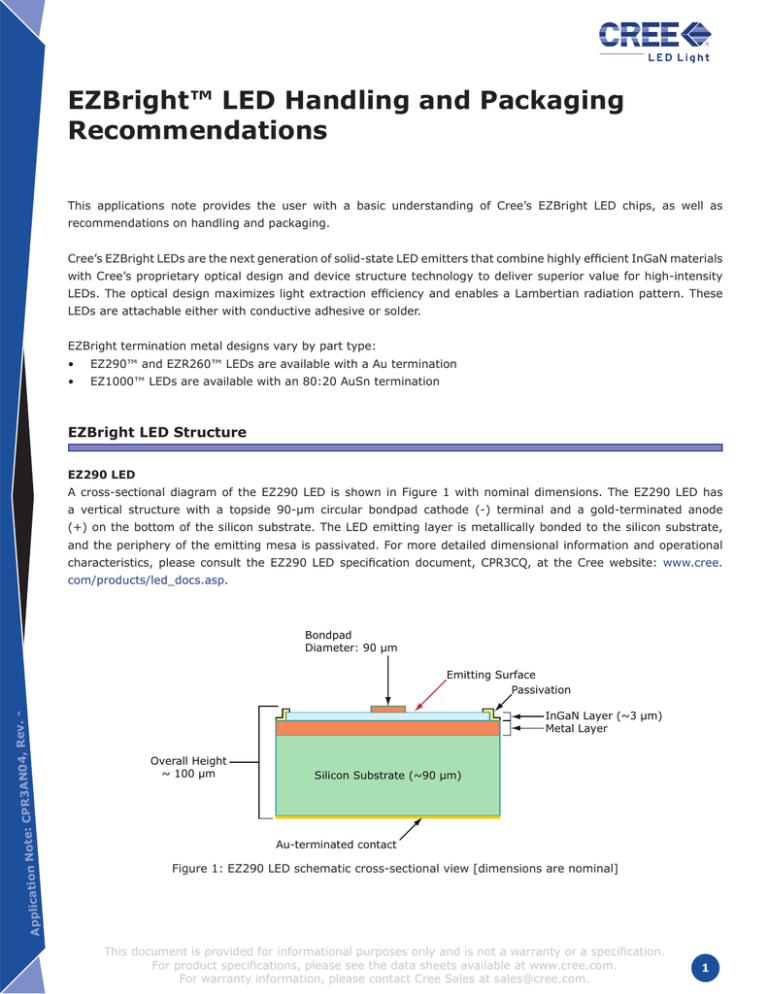
EZBright™ LED Handling and Packaging
Recommendations
This applications note provides the user with a basic understanding of Cree’s EZBright LED chips, as well as
recommendations on handling and packaging.
Cree’s EZBright LEDs are the next generation of solid-state LED emitters that combine highly efficient InGaN materials
with Cree’s proprietary optical design and device structure technology to deliver superior value for high-intensity
LEDs. The optical design maximizes light extraction efficiency and enables a Lambertian radiation pattern. These
LEDs are attachable either with conductive adhesive or solder.
EZBright termination metal designs vary by part type:
•
EZ290™ and EZR260™ LEDs are available with a Au termination
•
EZ1000™ LEDs are available with an 80:20 AuSn termination
EZBright LED Structure
EZ290 LED
A cross-sectional diagram of the EZ290 LED is shown in Figure 1 with nominal dimensions. The EZ290 LED has
a vertical structure with a topside 90-μm circular bondpad cathode (-) terminal and a gold-terminated anode
(+) on the bottom of the silicon substrate. The LED emitting layer is metallically bonded to the silicon substrate,
and the periphery of the emitting mesa is passivated. For more detailed dimensional information and operational
characteristics, please consult the EZ290 LED specification document, CPR3CQ, at the Cree website: www.cree.
com/products/led_docs.asp.
Bondpad
Diameter: 90 µm
04, Rev. ote: CPR3AN
Application N
Emitting Surface
Passivation
InGaN Layer (~3 µm)
Metal Layer
Overall Height
~ 100 µm
Silicon Substrate (~90 µm)
Au-terminated contact
Figure 1: EZ290 LED schematic cross-sectional view [dimensions are nominal]
This document is provided for informational purposes only and is not a warranty or a specification.
For product specifications, please see the data sheets available at www.cree.com.
For warranty information, please contact Cree Sales at sales@cree.com.
EZR260 LED
A cross-sectional diagram of the EZR260 LED is shown in Figure 2 with nominal dimensions. The EZR260 LED has a
vertical structure with a topside 100 μm wide x 100 μm semicircular bondpad cathode (-) terminal and a gold-terminated anode (+) on the bottom of the silicon substrate. The LED emitting layer is metallically bonded to the silicon
substrate, and the periphery of the emitting mesa is passivated. For more detailed dimensional information and operational characteristics, please consult the EZR260 LED specification document, CPR3CG, at the Cree website: www.
cree.com/products/led_docs.asp.
End Bondpad
Dimensions: 100 µm x 100 µm (semicircular)
Emitting Surface
Passivation
InGaN Layer
Metal Layer
Overall Height
~ 100 µm
Silicon Substrate (~90 µm)
Au-terminated contact
Figure 2: EZR260 LED schematic cross-sectional view [dimensions are nominal]
EZ1000 LED
A cross-sectional diagram of the EZ1000 LED is shown in Figure 3 with nominal dimensions. The EZ1000 LED has a
vertical structure with two topside 130 μm wide x 130 μm square bondpad cathode (-) terminals and an 80:20 AuSnterminated anode (+) on the bottom of the silicon substrate. The LED emitting layer is metallically bonded to the
silicon substrate, and the periphery of the emitting mesa is passivated. For more detailed dimensional information
and operational characteristics, please consult the EZ1000 LED specification document, CPR3CR, at the Cree website:
www.cree.com/products/led_docs.asp.
This document is provided for informational purposes only and is not a warranty or a specification. For product specifications, please see the data
sheets available at www.cree.com. For warranty information please contact Cree Sales at sales@cree.com.
Copyright © 2006 Cree, Inc. All rights reserved. The information in this document is subject to change without notice. Cree, and the Cree logo are
registered trademarks, and EZBright, EZ290, EZR260 and EZ1000 are trademarks of Cree, Inc. Other trademarks, product and company names are
the property of their respective owners and do not imply specific product and/or vendor endorsement, sponsorship or association.
CPR3AN04 Rev. -
Cree, Inc.
4600 Silicon Drive
Durham, NC 27703
USA Tel: +1.919.313.5300
www.cree.com
Two Corner Bondpads
Dimensions: 130 µm x 130 µm
Emitting Surface
Passivation
InGaN Layer
Metal Layer
Overall Height
~100 µm
Silicon Substrate (~90 µm)
AuSn-terminated contact
Figure 3: EZ1000 LED schematic cross-sectional view [dimensions are nominal]
EZBright LED Chip Handling
In general, industry-standard handling procedures can be used with the EZBright LED chip. EZBright LED chips are
shipped wire bond pad up, not requiring die transfer prior to die attach. Both coaxial and radial lighting sources (ring
or fiber lights) are recommended for pattern-recognition systems in automated pick-and-place or bonding processes.
Low-angle side lighting may also be used to provide improved contrast.
Several handling guidelines must be followed to maintain optimal performance:
•
Minimize contact between metallic fixtures, equipment, tweezers, or other hard objects and the emitting surface
or the edge of the junction mesa, as excessive contact force can damage the junction, leading to increased device
leakage and reduced optical output.
•
If possible, avoid application of tapes or adhesives to the emitting surface. Tape residue can contaminate the
textured surface, leading to reduced light extraction efficiency or poor lamp encapsulant adhesion.
•
Rubber collets and handling fixtures with hardness in the approximate range of 80 (Shore A), or equivalent, are
recommended. Harder plastic collets may also be used, in which case minimization of die placement or bonding
parameters (forces) is recommended. The selection of bonding force level should be confirmed through reliability
testing. See Table 1 for more information on collet selection.
•
Although the use of metal collets is not recommended for processing EZBright LEDs, it may be necessary in
situations where no alternative collet materials are available. The selection of bonding parameters should be
confirmed through reliability testing.
•
It is recommended that ejector pins contacting the backside surface of EZ1000 LEDs during the die pick process
have a minimum tip radius of 50 um in order to prevent chip damage.
Collets
A wide variety of rubber and plastic collets are available for use with EZBright LEDs. A selection of collets, sized for
This document is provided for informational purposes only and is not a warranty or a specification. For product specifications, please see the data
sheets available at www.cree.com. For warranty information please contact Cree Sales at sales@cree.com.
Copyright © 2006 Cree, Inc. All rights reserved. The information in this document is subject to change without notice. Cree, and the Cree logo are
registered trademarks, and EZBright, EZ290, EZR260 and EZ1000 are trademarks of Cree, Inc. Other trademarks, product and company names are
the property of their respective owners and do not imply specific product and/or vendor endorsement, sponsorship or association.
CPR3AN04 Rev. -
Cree, Inc.
4600 Silicon Drive
Durham, NC 27703
USA Tel: +1.919.313.5300
www.cree.com
use with EZ1000 LED and the smaller EZ290 and EZR260 LED chips, are shown in Table 1. Different collet materials,
including Teflon, Vespel, silicone rubber, Viton, etc., are compatible with different temperature ranges. Supplier
information is provided following Table 1; customers should contact the collet manufacturer for recommendations on
designs specific to their applications and die bonding equipment. Additional suppliers and designs are available; please
contact Cree (www.cree.com) for more information.
Some dimensional-critical applications, such as die bonding in narrow-walled side-view SMT packages, will require
specialty collets. In this case, a rectangular tipped collet may provide superior performance. One collet design proven
successful for this application using EZR260 is the SPT 2102D5-18-HTV-RT -0.23-0.40-0.13. This is a Vespel (hightemperature plastic) collet with rectangular tip geometry. Please contact the collet manufacturer for collet designs
compatible with specific package geometries.
Chip Size (μm)
Temperature
EZ1000
Material
Thermoplastic
OD (mm)
ID (mm)
Part #
0.76-1.02
0.40-0.50
PCTR-A-series
Low
SPT
Mid
Micro Mechanics
High Temp Rubber
0.75-1.00
0.40-0.50
HTR1A-series
Micro Mechanics
High Temp Rubber
0.75-1.00
0.40-0.50
HTR3-series
SPT
High Temp Rubber
0.76-1.02
0.4
HCTR-series
SPT
Vespel
0.76-1.00
0.38-0.50
2151-HTV21-CT-series
Micro Mechanics
High Temp Plastic
0.75-1.00
0.40-0.50
11-072-series
SKHC-F series
High
EZ290, EZR260
Supplier
Elastomer
Shukwang Mechatric Co.
High Temp Rubber
1
0.4
Low
Micro Mechanics
Rubber
0.25-0.38
0.15
13-124-series
High
SPT
Vespel
0.25-0.38
0.15
2151-HTV-CT-series
Micro Mechanics
High Temp Plastic
0.23-0.25
0.13-0.15
PT1-23-series
Table 1: Selected collets identified for evaluation with EZBright LED
Supplier Information
Micro Mechanics
(www.micro-mechanics.com)
Singapore, China, Taiwan, Japan
Small Precision Tools (SPT)
(www.smallprecisiontools.com)
USA, Singapore, China, Japan
Shukwang Mechatric Co., Ltd.
2nd Floor, Buri B/D, 71-15, Oguem-Dong, Songpa Gu, 138-857, Seoul, Korea
Ph: 82-2-4076832
This document is provided for informational purposes only and is not a warranty or a specification. For product specifications, please see the data
sheets available at www.cree.com. For warranty information please contact Cree Sales at sales@cree.com.
Copyright © 2006 Cree, Inc. All rights reserved. The information in this document is subject to change without notice. Cree, and the Cree logo are
registered trademarks, and EZBright, EZ290, EZR260 and EZ1000 are trademarks of Cree, Inc. Other trademarks, product and company names are
the property of their respective owners and do not imply specific product and/or vendor endorsement, sponsorship or association.
CPR3AN04 Rev. -
Cree, Inc.
4600 Silicon Drive
Durham, NC 27703
USA Tel: +1.919.313.5300
www.cree.com
EZBright LED Die Attach
All EZBright LED chips can be attached using electrically conductive adhesive (e.g. Ag epoxy). The EZ290 LED chip is
specifically designed for Ag-epoxy die attach, with a target bond depth of 35 μm and a maximum depth of 50 μm. It is
important that the epoxy completely underfill the EZBright LED chip, as this will ensure adequate die adhesion and will
provide a rigid support to the chip during subsequent wirebonding.
EZBright LED chips can also be attached using solder. EZ290 LED and EZR260 LED chips are supplied with Au terminations and, therefore, require solder paste or solder preforms to achieve a solder joint. EZ1000 LEDs are supplied with
an 80:20 AuSn termination, which enables die attach using a flux eutectic reflow process, in addition to die attach using Ag epoxy or alternate solders. For all solder attach processes, the following guidelines must be observed:
•
The maximum reflow process conditions for EZ290 LED and EZR260 LED chips are 270°C for 10 seconds. This
process window is adequate for the reflow of a range of solders, including Pb-free solders. It is recommended that
temperature profiles be verified by direct measurement at the LED chip to ensure that the maximum process
limits are not exceeded.
•
The maximum reflow process conditions for EZ1000 LEDs are 325°C for 5 seconds. This process window is adequate for the reflow of 80:20 AuSn and a range of other solders, including Pb-free solders. It is recommended that
temperature profiles be verified by direct measurement at the LED chip to ensure that the maximum process
limits are not exceeded.
•
Only no-clean fluxes should be used, either in the solder paste or in the flux-eutectic reflow process. Cree suggests the following flux brands:
◊
Alpha Metals UP78 (or UP78-PT equivalent) (U.S.)
◊
Arakawa WHP-002 (Japan/Asia)
◊
Indium TACFlux 007 (U.S./Japan/Asia)
Alternative fluxes should be evaluated by the customer, as appropriate.
•
Flux residue should be cleaned in isopropyl alcohol in an ultrasonic bath for 15 minutes prior to wirebonding and
encapsulation. Alternate liquid cleaning processes may be suitable but must be thoroughly evaluated for compatibility with the EZBright LED chip.
•
If plasma cleaning is a customer consideration, Cree recommends that the devices not be exposed to hydrogen
plasmas. Addition of hydrogen to other types of plasma should be minimized.
•
Minimal pressure should be applied to the EZBright chip during the soldering process. Pressure eutectic attach
of EZ1000 LEDs is not a Cree-recommended process; however, if the customer elects to use this process, then a
maximum bonding force of 50 grams is recommended.
•
Complete solder underfill of the EZBright chip is required to provide a rigid support to the chip for subsequent
wirebonding.
Additional information about flux eutectic die attach of Cree LED chips can be found in Applications Guide CPR3-AN03;
all of the handling and process guidelines described in this document must be observed for die attach of EZBright
LEDs.
This document is provided for informational purposes only and is not a warranty or a specification. For product specifications, please see the data
sheets available at www.cree.com. For warranty information please contact Cree Sales at sales@cree.com.
Copyright © 2006 Cree, Inc. All rights reserved. The information in this document is subject to change without notice. Cree, and the Cree logo are
registered trademarks, and EZBright, EZ290, EZR260 and EZ1000 are trademarks of Cree, Inc. Other trademarks, product and company names are
the property of their respective owners and do not imply specific product and/or vendor endorsement, sponsorship or association.
CPR3AN04 Rev. -
Cree, Inc.
4600 Silicon Drive
Durham, NC 27703
USA Tel: +1.919.313.5300
www.cree.com
EZBright LED Wire Bonding
EZBright LED chips are designed for Au-ball wirebonding. It is important that the entire ball bond remain within the
confines of the bondpad area and that no metal contact the emitting surface. Care must also be taken to prevent the
wire capillary fixture from contacting the emitting surface as this can damage the LED junction.
Customers experienced with Cree’s SiC-based chips may have developed wirebonding parameters suitable to the very
rigid and hard characteristics of the SiC substrate. These existing parameters may need to be re-evaluated for the
EZBright LED, which is constructed on a lower-rigidity silicon substrate. If the customer suspects that the wirebonding
process is damaging the EZBright chip, then the following should be considered:
•
Wirebonding force and ultrasonic power should be minimized
•
Capillary geometry should be changed to minimize the force required for ball formation
•
Wirebonding process temperatures may be increased to reduce the required bonding forces/powers
•
Use softer Au wire
Absolute bonding parameters for EZBright LED chips cannot be specified since bonding equipment and materials vary
greatly. Table 2 lists target parameters that may be used as a guideline for wirebond development. Customer are
advised to optimize bonding parameters on their specific equipment.
Wirebonding Parameter*
Contact Force
Bond Time
Bond Force
Ultrasonic Power
Target Value
50 g-force
9-12 ms
35-40 g-force
100 mW
* Parameters based on settings for ASM Eagle 60 Au-ball bonder using 1.0 and 1.2 mil
Au wire at 160°C bonding temperature, Gaiser 1572-17-437GM-20D capillary, 138 kHz
ultrasonic frequency.
Table 2: Target wirebonding parameters
The EZ290 LED chip (Figure 4) features a centered circular Au bondpad, nominally 90 μm in diameter. A maximum
wire diameter of 1 mil (25 μm) is recommended in order to remain within the 90-μm diameter bondpad region.
The EZR260 LED (Figure 5) features a Au bondpad located at the narrow end of the chip, nominally 100 μm wide and
100 μm to the apex of the semicircular geometry. A wire diameter of 1 mil (25 μm) is recommended in order to remain within the 100-μm diameter bondpad region.
The EZ1000 LED (Figure 6) features two 130-μm square Au bondpads located in adjacent corners. This two-bondpad
configuration allows the option of either single-or double-wirebonding, though double wirebonding is recommended
for optimal performance. Wire diameters up to 1.25 mil (30 μm) are recommended, but caution must be observed for
larger wires in maintaining the bond within the pad area.
This document is provided for informational purposes only and is not a warranty or a specification. For product specifications, please see the data
sheets available at www.cree.com. For warranty information please contact Cree Sales at sales@cree.com.
Copyright © 2006 Cree, Inc. All rights reserved. The information in this document is subject to change without notice. Cree, and the Cree logo are
registered trademarks, and EZBright, EZ290, EZR260 and EZ1000 are trademarks of Cree, Inc. Other trademarks, product and company names are
the property of their respective owners and do not imply specific product and/or vendor endorsement, sponsorship or association.
CPR3AN04 Rev. -
Cree, Inc.
4600 Silicon Drive
Durham, NC 27703
USA Tel: +1.919.313.5300
www.cree.com
Important: Both the EZ1000 Led and the EZR260 LED chips feature bondpads adjacent to the edge of the junction
mesa. Care must be taken to prevent any wirebond metal from exceeding the bondpad geometry confines and lapping
over the edge of the mesa as this could lead to shunting leakage and/or junction damage.
Au Bondpad
Au Bondpad
90-μm diameter
100 x 100 μm
Figure 4: EZ290 LED
Figure 5: EZR260 LED
Au Bondpads
130 x 130 μm
Figure 6: EZ1000 LED
This document is provided for informational purposes only and is not a warranty or a specification. For product specifications, please see the data
sheets available at www.cree.com. For warranty information please contact Cree Sales at sales@cree.com.
Copyright © 2006 Cree, Inc. All rights reserved. The information in this document is subject to change without notice. Cree, and the Cree logo are
registered trademarks, and EZBright, EZ290, EZR260 and EZ1000 are trademarks of Cree, Inc. Other trademarks, product and company names are
the property of their respective owners and do not imply specific product and/or vendor endorsement, sponsorship or association.
CPR3AN04 Rev. -
Cree, Inc.
4600 Silicon Drive
Durham, NC 27703
USA Tel: +1.919.313.5300
www.cree.com




